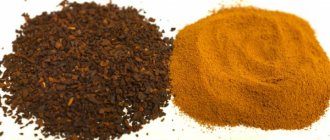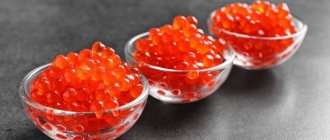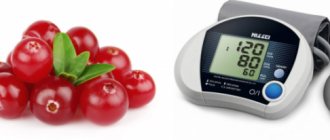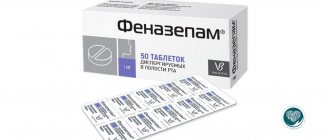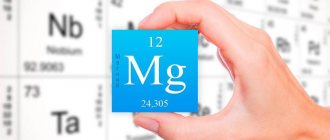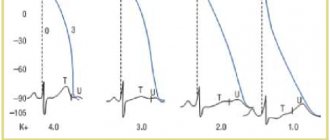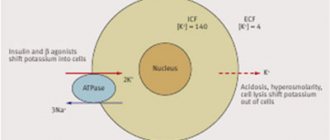In this article we will tell you:
- Beneficial properties of potassium and its effect on the body
- How much potassium does a person need?
- How to determine potassium deficiency
- Signs of excess potassium
- What foods contain potassium?
- Foods containing large amounts of potassium
- Rules for preparing foods with potassium
- Menu for a healthy heart
Potassium
- an important trace element and electrolyte. It maintains water-salt balance, promotes proper heart function, and regulates the activity of the central nervous system.
Deficiency of this microelement leads to various ailments. And first of all, it is recommended to reconsider your diet. From today's article you will learn what foods contain potassium, how to determine potassium deficiency, how much it is needed during the day and how to properly prepare foods with potassium to replenish it in the body.
Beneficial properties of potassium and its effect on the body
Potassium
– this is one of the electrolytes, i.e. mineral compounds that can conduct electricity when dissolved in water. More than 95% of all potassium is found inside the cells of the body.
Why are electrolytes important?
Electrolytes are needed to transmit electrical impulses to the heart, maintain fluid balance in and outside of cells, and signal muscle contraction. When electrolytes are lost, for example through sweat during exercise, without being replaced, it can lead to muscle cramps.
Electrolytes always form pairs. Potassium works closely with sodium, and together these two microelements play a huge role in maintaining the health of every cell in the body:
- water balance and fluid distribution;
- acid-base balance;
- work of muscle and nerve cells;
- heart function;
- functions of the kidneys and adrenal glands.
Thus, in the cells of our body there is a pump called the sodium-potassium pump. This pump feeds chemical energy in the form of ATP and then removes sodium from the cells, allowing potassium to enter the cell. During each pump cycle, three sodium ions leave the cell and two potassium ions enter it.
The sodium-potassium pump also maintains electrical charge within the cell, which is especially important for muscle and nerve cells. When nerve impulses are transmitted or muscles contract, potassium leaves the cell and sodium takes its place, resulting in a change in electrical charge. It is this change that triggers the nerve impulse or muscle contraction. It is not at all surprising that a lack of potassium first affects the functioning of muscles and nerve cells.
A diet high in sodium and low in potassium makes this pump difficult to operate.
How is blood pressure regulated?
Before we understand the role of potassium in regulating blood pressure, it is important to have an understanding of how our pressure thermostat works. This thermostat involves a complex coordination of mechanisms regulated by our nervous system, kidneys, endocrine system that creates hormones, the heart, our blood vessels, the amount of fluid flowing in the blood vessels, our electrolyte levels and much more.
Sometimes it seems trivial (like when you say “my blood pressure is 120/80”), but it is fascinating to realize how this ultra-complex mechanism must work in perfect coordination every second of our lives.
How much potassium does a person need?
In different countries, the average potassium intake is less than 3000 mg per day, i.e. lower than recommended by WHO - it is advisable for adults to receive at least 3510 mg of potassium per day
.
For example, the average per capita consumption of potassium by the population of the Republic of Sakha (Yakutia) is 2107 mg. The average potassium intake by adult men in the Stavropol Territory is close to the norm and higher than that of women. Potassium consumption by persons with cardiovascular diseases (CVD) and obesity in the Moscow region was 3144 mg.
The daily need for potassium depends on age, physical condition and even place of residence. Healthy adults need 2.5 g of potassium, pregnant women – 3.5 g, athletes – up to 5 grams of potassium daily. The amount of potassium for adolescents is calculated by weight - 20 mg of potassium per 1 kg of body weight.
Potassium norms are calculated for all age categories and are presented in the table below:
| Categories | Daily norm |
| Children under 2 years old | 400-600 mg |
| Children from 3 to 5 years old | 3000 mg |
| Children from 6 to 8 years old | 3800 mg |
| Children from 9 to 13 years old | 4500 mg |
| Teenagers under 18 years old | 4600 mg |
| Women | 4700 mg |
| Women during pregnancy and lactation | 5 100 mg |
| Men | 4800 mg |
The body's daily need for potassium increases
:
- in patients with type 1 diabetes, as well as in those prescribed non-steroidal anti-inflammatory drugs;
- when taking diuretics;
- with a low-carbohydrate and high-protein diet: in such cases, the diet practically does not include fruits, the alkaline composition of which regulates potassium metabolism;
- during sports activities: potassium is intensively excreted from the body through sweat.
In most physiological processes, potassium acts as an antagonist to sodium, so maintaining good health requires a sodium to potassium diet ratio of 1:2 to 1:4.
Excess sodium in the body, which is harmful to health, can be neutralized by adding extra potassium. This is the basis for the treatment of edematous conditions with a diet enriched with potassium.
We recommend
“Body detox: how to do it correctly” Read more
The average daily sodium intake ranges between 2500 and 7500 mg. Most of this amount enters the body in the form of sodium chloride or salt. How much sodium does our body actually need per day? Oddly enough, this is only 200 mg, i.e. 10-30 times less than average consumption.
A deficiency of one of these elements leads to an excess of another and, as a consequence, to a malfunction in certain body systems.
Thus, balancing sodium and potassium is much more important than maintaining a specific amount.
A Brief History of Hypertension
It's hard to imagine that modern technology for measuring blood pressure has only been around for a little over 100 years (when Russian surgeon Dr. Kortokov described the method in an article). Previously, no one knew what “normal” blood pressure should be in a person. Population-based studies were later conducted to answer this question. With this knowledge came the realization that high blood pressure can increase the risk of cardiovascular disease.
Unfortunately, in the early 20th century there was no good treatment for hypertension. Whatever small treatment strategies there were, they look almost medieval and barbaric by today's standards.
These include bloodletting through phlebotomy or even kidney cutting. In fact, high blood pressure has even been referred to as malignant hypertension, the word malignant suggesting that the prognosis is as bad as cancer.
How to determine potassium deficiency
Potassium deficiency is characterized by the following symptoms
:
- fatigue, weakness, loss of strength;
- high blood pressure;
- muscle weakness, spasms and cramps;
- cardiac arrhythmia;
- constipation;
- tingling and numbness in the arms and legs;
- swelling;
- dizziness.
These symptoms indicate low levels of energy reserves in the muscles. The fact is that potassium is necessary to convert blood sugar into glycogen.
Because glycogen is used by muscles as an energy source, potassium deficiency causes noticeable fatigue and muscle weakness.
Leg cramps, especially ones that wake you up in the middle of the night, can also be associated with low magnesium and calcium levels.
Insufficient amounts of potassium and magnesium can contribute to the development of chronic fatigue syndrome. Often, just replenishing the body's mineral reserves with equal amounts (250-500 mg) of organic potassium and magnesium salts is enough to restore muscle tone, increase energy levels and increase endurance.
Results can often be noticeable in as little as a week. If this duo doesn't help on its own, it may still be a useful addition to treating other types of fatigue.
What can cause potassium deficiency?
In addition to insufficient potassium in the diet:
- consumption of foods not saturated with this element;
- increased excretion of potassium from the body along with urine;
- hyperfunction of the adrenal cortex and anterior pituitary gland;
- primary and secondary aldosteronism (increase in the hormone aldosterone);
- increased secretion of antidiuretic hormone;
- active treatment with corticosteroids;
- taking large amounts of potassium-free liquid for vomiting and diarrhea;
- diabetes;
- diabetes insipidus;
- magnesium deficiency;
- cystic fibrosis;
- acidosis.
The amount of potassium excreted through sweat can be very significant, especially during long exercise sessions in the heat. Athletes or people who exercise regularly may have a high need for this micronutrient.
Foods with a healthy element
To prevent a deficiency of these macroelements and thereby protect yourself from heart and vascular diseases, you need to know which foods contain the maximum amount of useful substances. For convenience, all data will be presented in a table.
| Product name | Amount of potassium (mg) | Amount of magnesium (mg) | Benefit |
| White mushroom (dried) | 3937 | — | Cleanses blood vessels and improves the functioning of the heart muscle |
| Celery root (dried) | 2759 | — | Stimulates the functioning of the digestive tract, improves the functioning of the cardiovascular system, is useful for diabetes, and is useful for atherosclerosis. |
| Cilantro | 2050 | — | Normalizes digestion, improves the functioning of the heart and blood vessels, and helps digest heavy foods. |
| Dried apricots | 1780 | — | Improves vision, strengthens the body's immune system. |
| Saffron | 1730 | — | Prevention of malignant neoplasms, normalizes liver function, eliminates excess bile in the body. |
| Natural coffe | 1550 | — | Reduces the risk of asthma, reduces the risk of diabetes, and resists the appearance of gallstones. |
| Beans | 1150 | — | Strengthens muscle tissue, strengthens the immune system, neutralizes the effects of free radicals. |
| Egg white | 1050 | — | Low-calorie source of complete proteins |
| Sea kale | 950 | — | Improves metabolism, improves the functioning of the digestive tract, improves the functioning of the urinary system. |
| Mash | 970 | — | Antioxidant, regulates blood sugar levels, low-calorie product with a large supply of vitamins. |
| Chickpeas | 950 | — | Improves digestion and heart function, increases the elasticity of blood vessels. |
| Peas | 880 | — | Increases the body's performance and improves brain activity. |
| Prunes | 850 | — | Normalizes blood pressure, improves gastrointestinal function, and helps normalize body weight. |
| Raisin | 850 | — | Prevention of anemia, improves vision. |
| Sesame | — | 539 | Lowers blood pressure, regulates cholesterol levels in the blood, improves intestinal function, and strengthens the bone skeleton. |
| Wheat bran | — | 446 | Strengthens intestinal motility, reduces appetite, helps reduce weight. |
| Cedar nut | — | 250 | Strengthens the body's immune system, reduces appetite, regulates blood cholesterol levels. |
| Cashew | — | 269 | Reduces hunger and helps lose weight. |
| Hazelnut | — | 159 | Strengthens the cardiovascular system and improves intestinal function. |
| bitter chocolate | — | 132 | Rich in antioxidants, stimulates brain activity. |
| Pistachios | — | 120 | Prevention of anemia, improve reproductive function in men. |
| Rye | — | 119 | Improves the functioning of the digestive tract, enriching the body with vitamins and fiber. Helps to lose excess weight. |
| Sunflower seeds | — | 315 | Improves brain activity, contains polyunsaturated fats |
| Barley | — | 160 | Prevents the formation of malignant tumors, a natural source of antioxidants, thins the blood. |
| Avocado | — | 30 | Supplies tissues with oxygen, improves digestion, regulates cholesterol levels in the blood. |
| A pineapple | — | 10 | Improves the functioning of the gastrointestinal tract, strengthens the immune system, helps cope with inflammatory processes. |
| Sea buckthorn | — | 30 | Prevention of vitamin deficiency, colds; blocks inflammatory processes, treats burns (locally). |
| Black currant | — | 30 | Strengthens the cardiovascular and nervous systems, preventing arthritis. |
| Rose hip | — | 7 | Strengthens the immune system, helps cope with colds, and enriches the body with vitamin C. |
Fortunately, most products can be easily found on store shelves and supermarkets, and most of these products are suitable for both adults and children. The only contraindication, perhaps, will be individual intolerance to a particular product. But this issue is easily resolved by replacing the allergen with a more suitable and favorite product.
Signs of excess potassium
Not only a lack of potassium, but also too much potassium is dangerous.
Symptoms resemble microelement deficiency, so it is advisable to get tested
In such cases, the following symptoms occur
:
- increased excitability of the nervous system, irritability, anxiety;
- sweating;
- weakness;
- cardiopsychoneurosis;
- intestinal colic;
- frequent urination.
A healthy person should not worry about a possible overdose. Normally, excess microelement is excreted through the kidneys.
If a person is diagnosed with hyperkalemia, he is sent for examination.
The causes of excess potassium are
:
- renal failure;
- hemolytic anemia;
- malignant tumors;
- dehydration;
- anaphylactic shock;
- hypofunction of the adrenal cortex (Addison's disease).
If potassium levels are elevated, it is recommended to limit potassium-rich foods.
Modern methods of treating high blood pressure
Today, doctors no longer have to play vampire to treat their patients.
This is due in part to an improved understanding of human blood pressure physiology and the influence of external factors such as diet (which includes electrolytes such as sodium, potassium, etc.). However, like many problems, the more we learn, the more questions arise.
Thus, the average person may be mistaken in thinking that the modern physician has perfected the art and science of treating blood pressure. But even today, the treatment and approach to hypertension is still the subject of intense research and debate. One need only look at the several guidelines published by organizations around the world that tell the average physician when and how to treat high blood pressure. Each of them claims to be the final word on the subject; that is, until the next guide comes along.
What foods contain potassium?
All products containing potassium (K) are usually classified taking into account the concentration of this useful mineral in them:
- low-potassium (100 mg of component per 100 g of product);
- with an average potassium content (150-200 mg per 100 g);
- with a high potassium content (260-400 mg per 100 g);
- saturated with potassium (more than 400 mg per 100 g).
Plant sources of potassium
Products of plant origin are a real storehouse of useful potassium compounds. Among them there is a wide variety of vegetables, fruits and berries containing this mineral.
For example, potassium in fruits is perfectly absorbed, since the combination of glucose and insulin is very effective, which promotes the transfer of potassium into cells.
Vegetables and fruits contain a lot of potassium and little sodium.
Potassium content in nuts and seeds:
| The product's name | Potassium content per 100g |
| Peanut | 658 mg |
| Walnut | 474 mg |
| Dried acorns | 709 mg |
| Pine nut | 597 mg |
| Cashew | 553 mg |
| Sesame | 497 mg |
| Almond | 748 mg |
| Sunflower seeds (seeds) | 647 mg |
| Pistachios | 1025 mg |
| Hazelnut | 445 mg |
Potassium content in cereals and grain products:
| The product's name | Potassium content per 100g |
| Buckwheat (grain) | 325 mg |
| Buckwheat (prodel) | 320 mg |
| Buckwheat (kernel) | 380 mg |
| Corn grits | 147 mg |
| Semolina | 130 mg |
| Oatmeal | 362 mg |
| Pearl barley | 172 mg |
| Wheat groats | 230 mg |
| Millet groats (polished) | 211 mg |
| Rice groats | 100 mg |
| Barley groats | 205 mg |
| Sweet corn | 270 mg |
| Pasta made from 1st grade flour | 178 mg |
| Premium flour pasta | 123 mg |
| Buckwheat flour | 577 mg |
| Corn flour | 147 mg |
| Oat flour | 280 mg |
| Oat flour (oatmeal) | 351 mg |
| Wheat flour 1st grade | 176 mg |
| Wheat flour 2 grades | 251 mg |
| Premium wheat flour | 122 mg |
| Wheat flour | 310 mg |
| Peeled rye flour | 600 mg |
| Rye wallpaper flour | 396 mg |
| Seeded rye flour | 200 mg |
| Rice flour | 50 mg |
| Oats (grain) | 421 mg |
| Oat bran | 566 mg |
| Wheat bran | 1260 mg |
| Wheat (grain, soft variety) | 337 mg |
| Wheat (grain, durum) | 325 mg |
| Rice (grain) | 314 mg |
| Rye (grain) | 424 mg |
| Oat flakes "Hercules" | 330 mg |
| Barley (grain) | 453 mg |
Potassium content in legumes:
| The product's name | Potassium content per 100g |
| Peas (shelled) | 731 mg |
| Green peas (fresh) | 285 mg |
| Mash | 1000 mg |
| Chickpeas | 968 mg |
| Soybean (grain) | 1607 mg |
| Beans (grain) | 1100 mg |
| Green beans) | 260 mg |
| Lentils (grain) | 672 mg |
Potassium content in fruits, berries, dried fruits:
| The product's name | Potassium content per 100g |
| Apricot | 305 mg |
| Avocado | 485 mg |
| Quince | 144 mg |
| Cherry plum | 188 mg |
| A pineapple | 321 mg |
| Orange | 197 mg |
| Watermelon | 110 mg |
| Banana | 348 mg |
| Cowberry | 90 mg |
| Grape | 225 mg |
| Cherry | 256 mg |
| Blueberry | 51 mg |
| Pomegranate | 150 mg |
| Grapefruit | 184 mg |
| Pear | 155 mg |
| Dried pear | 872 mg |
| Durian | 436 mg |
| Melon | 118 mg |
| Blackberry | 208 mg |
| Strawberries | 161 mg |
| Raisin | 830 mg |
| Fresh figs | 190 mg |
| Dried figs | 710 mg |
| Kiwi | 300 mg |
| Cranberry | 119 mg |
| Gooseberry | 260 mg |
| Dried apricots | 1717 mg |
| Lemon | 163 mg |
| Raspberries | 224 mg |
| Mango | 168 mg |
| Mandarin | 155 mg |
| Cloudberry | 180 mg |
| Nectarine | 201 mg |
| Sea buckthorn | 193 mg |
| Papaya | 182 mg |
| Peach | 363 mg |
| Dried peach | 2043 mg |
| Pomelo | 216 mg |
| Red rowan | 230 mg |
| Rowan chokeberry | 158 mg |
| Plum | 214 mg |
| White currant | 270 mg |
| Red currants | 275 mg |
| Black currant | 600 mg |
| Dried apricots | 1781 mg |
| Feijoa | 172 mg |
| Dates | 370 mg |
| Persimmon | 200 mg |
| Cherries | 233 mg |
| Blueberry | 51 mg |
| Prunes | 864 mg |
| Rose hip | 23 mg |
| Apples | 278 mg |
| Dried apples | 580 mg |
Potassium content in vegetables and herbs:
| The product's name | Potassium content per 100g |
| Basil (greens) | 295 mg |
| Eggplant | 238 mg |
| Swede | 238 mg |
| Ginger (root) | 415 mg |
| Zucchini | 238 mg |
| White cabbage | 300 mg |
| Broccoli | 316 mg |
| Brussels sprouts | 600 mg |
| Kohlrabi cabbage | 370 mg |
| Red cabbage | 302 mg |
| Cabbage | 238 mg |
| Savoy cabbage | 238 mg |
| Cauliflower | 210 mg |
| Potato | 568 mg |
| Cilantro (greens) | 521 mg |
| Watercress (greens) | 606 mg |
| Dandelion leaves (greens) | 397 mg |
| Green onion (feather) | 259 mg |
| Leek | 225 mg |
| Bulb onions | 175 mg |
| Carrot | 200 mg |
| Sea kale | 970 mg |
| Cucumber | 141 mg |
| Fern | 370 mg |
| Parsnip (root) | 529 mg |
| Sweet pepper (Bulgarian) | 163 mg |
| Parsley (greens) | 800 mg |
| Parsley (root) | 342 mg |
| Pomodoro (tomato) | 290 mg |
| Rhubarb (greens) | 325 mg |
| Radish | 255 mg |
| Black radish | 357 mg |
| Turnip | 238 mg |
| Lettuce (greens) | 220 mg |
| Beet | 288 mg |
| Celery (greens) | 430 mg |
| Celery (root) | 393 mg |
| Asparagus (greens) | 196 mg |
| Jerusalem artichoke | 200 mg |
| Pumpkin | 204 mg |
| Dill (greens) | 335 mg |
| Horseradish (root) | 579 mg |
| Garlic | 260 mg |
| Spinach (greens) | 774 mg |
| Sorrel (greens) | 500 mg |
Animal products containing potassium
Do not neglect animal products - they also contain potassium reserves.
Potassium content in meat, fish and seafood:
| The product's name | Potassium content per 100g |
| Vobla | 160 mg |
| Pink salmon | 335 mg |
| Red granular caviar | 90 mg |
| Pollock caviar | 60 mg |
| Black granular caviar | 80 mg |
| Squid | 280 mg |
| Flounder | 320 mg |
| Chum salmon | 335 mg |
| Baltic sprat | 380 mg |
| Caspian sprat | 600 mg |
| Shrimp | 220 mg |
| Bream | 265 mg |
| Atlantic salmon (salmon) | 420 mg |
| Mussels | 310 mg |
| Pollock | 420 mg |
| capelin | 290 mg |
| Meat (lamb) | 270 mg |
| Meat (beef) | 326 mg |
| Meat (turkey) | 210 mg |
| Meat (rabbit) | 335 mg |
| Meat (chicken) | 194 mg |
| Meat (fatty pork) | 230 mg |
| Meat (pork meat) | 285 mg |
| Meat (broiler chickens) | 236 mg |
| Navaga | 335 mg |
| Sea bass | 300 mg |
| River perch | 280 mg |
| Sturgeon | 280 mg |
| Halibut | 450 mg |
| Beef liver | 277 mg |
| Haddock | 300 mg |
| Beef kidneys | 237 mg |
| Crayfish | 250 mg |
| Carp | 280 mg |
| Salaka | 210 mg |
| Fatty herring | 310 mg |
| Lean herring | 31 mg |
| Medium salted herring | 215 mg |
| Mackerel | 280 mg |
| Som | 240 mg |
| Horse mackerel | 600 mg |
| Zander | 280 mg |
| Cod | 340 mg |
| Tuna | 600 mg |
| Acne | 230 mg |
| Oyster | 220 mg |
| Hake | 335 mg |
| Pike | 260 mg |
Potassium content in dairy products and egg products:
| The product's name | Potassium content per 100g |
| Acidophilus | 145 mg |
| Chicken egg white | 152 mg |
| Cheese cheese (from cow's milk) | 95 mg |
| Varenets 2.5% | 144 mg |
| Chicken egg yolk | 129 mg |
| Yogurt 1.5% | 152 mg |
| Yogurt 3.2% | 147 mg |
| Kefir | 146 mg |
| Kumis (mare's milk) | 77 mg |
| Low-fat kumiss (from cow's milk) | 146 mg |
| Milk | 146 mg |
| Goat milk | 204 mg |
| Yogurt 2.5% | 144 mg |
| Ryazhenka | 146 mg |
| Cream 10% | 124 mg |
| Cream 20% | 109 mg |
| Cream 35% | 90 mg |
| Sour cream 10% | 124 mg |
| Sour cream 15% | 116 mg |
| Sour cream 20% | 109 mg |
| Sour cream 25% | 100 mg |
| Sour cream 30% | 95 mg |
| Cheese "Adygei" | 70 mg |
| Cheese "Dutch" 45% | 100 mg |
| Camembert cheese | 75 mg |
| Parmesan cheese | 92 mg |
| Cheese "Poshekhonsky" 45% | 95 mg |
| Cheese "Roquefort" 50% | 110 mg |
| Cheese "Russian" 50% | 88 mg |
| Sulguni cheese" | 100 mg |
| Chees Feta" | 62 mg |
| Cheddar cheese 50% | 116 mg |
| Swiss cheese 50% | 100 mg |
| Gouda cheese | 121 mg |
| Cottage cheese 18% (fat) | 112 mg |
| Cottage cheese 2% | 78 mg |
| Cottage cheese 4% | 112 mg |
| Cottage cheese 5% | 112 mg |
| Chicken egg | 140 mg |
| Quail egg | 144 mg |
Among all the listed products, we will highlight the TOP products in terms of potassium content, availability, ease of preparation and absorption by the body. Food products containing potassium in large quantities
- Potato
One medium potato contains 900 mg of potassium. By eating just one potato as a side dish for lunch, you can get a little more than 1/5 of your daily potassium requirement. To absorb potassium, give preference to baked potatoes.
Potatoes also contain vitamin C, vitamin B6, iron, and fiber (especially in the skin). When cooled, potato starch nourishes beneficial intestinal microflora.
- Sun-dried tomatoes
Fresh tomatoes also contain potassium. But there is much more of it in dried tomatoes or tomato paste. It is better to prepare these products yourself or choose them in a store with a good composition - without added sugar and preservatives.
We recommend
"Can food heal people: the power of good nutrition" Read more
A cup of these tomatoes contains 1,800 mg of potassium, which is about 40% of the daily recommended amount.
In addition, tomatoes contain a lot of fiber, vitamin C, vitamin E, improve the digestive and immune system and are good for the heart.
- Beans
Red and white beans are equally beneficial for the body. One cup of red beans contains 600 mg, white beans - 1,000 mg. Beans are high in fiber, protein and iron. It can be added to soups and salads.
- Dried apricots
The concentration of nutrients contained in fresh apricots increases when dried. Therefore, 100 grams of dried apricot contains 1.162 mg of potassium.
- Prunes
In addition to potassium (686 mg in ½ cup), prunes contain vitamins B1, B2, C, magnesium, phosphorus and iron.
- Avocado
One avocado contains approximately 975 mg of potassium, as well as magnesium, phosphorus, iron, zinc, various vitamins and healthy fats, which are so important for heart health and good skin condition.
- Salmon
In 100 grams you can find 420 mg of potassium - this is more than in any other fish. In addition, red fish is rich in omega-3 and vitamin D.
- Spinach
An excellent side dish for fish and meat dishes, as well as a frequent ingredient in the most delicious smoothies, it contains 774 mg of potassium per 100 grams.
- Pumpkin
There are many varieties of pumpkin, and the amount of potassium depends on this. For example, 100 grams of cooked acorn squash contains 437 mg, and winter squash contains 448 mg.
- Oranges
In addition to vitamin C and B vitamins, folic acid, oranges also contain potassium. With one glass of juice you will get about 473 mg of potassium.
First symptoms of overdose
Potassium overdose
To begin with, it is worth noting that the maximum daily dose is 6 grams. Consuming 14 grams can cause cardiac arrest. If you do not follow the dosage and take the drug for longer than prescribed, the person may experience the following unpleasant symptoms:
- Mood swings and irritability.
- Unjustified anxiety and suspiciousness.
- Muscle weakness and body aches.
- Heart rhythm disorder.
- Colic and bloating.
- Digestive system upset and vomiting.
- Frequent urination.
- Diabetes.
For magnesium, the daily dosage should not exceed 800 mg per day. Fortunately, you cannot die from an overdose, but a person may experience constant fatigue and apathy, kidney stones and sand, psoriasis, and hyperthyroidism. Among the main symptoms of excess substance are:
- Dry mucous membranes.
- Slowing heart rate.
- Impaired speech and coordination.
- Drowsiness and fatigue.
- Digestive disorder.
- Hyperfunction of the thyroid gland.
- Arthritis.
It is worth noting that the retention and accumulation of magnesium in the body is provoked by chronic renal failure. If you experience a negative reaction from your body when taking combination medications, you should stop taking the medication and consult your doctor.
Rules for preparing foods with potassium
As you can see, there are many sources of potassium. But it is equally important to know how to properly prepare dishes so that the body retains and absorbs as much potassium as possible.
The main requirement for vegetables and fruits is freshness and absence of damage. There is noticeably less potassium in wilted fruits. It is best to store them in a dry and cool place.
The amount of nutrients in finished food is affected by the cooking temperature, interaction with oxygen, and the acidity level of the dish. Potassium, like most vitamins, is destroyed by strong heat, especially during prolonged cooking. Therefore, you need to cook quickly, trying to reduce the processing temperature as much as possible.
We recommend
“Nutrition for a healthy lifestyle: healthy foods, life hacks, menus” Read more
The component does not tolerate cooking or soaking - with this treatment, the mineral quickly passes into water.
After cooking vegetables, most of the potassium is not stored in the pulp, but goes into a decoction, which is usually poured out after cooking. Therefore, plant foods rich in potassium and magnesium are best baked or served raw.
For example, steamed spinach has 17% less potassium than fresh spinach. And when cooked, curly cabbage loses up to 50% of the valuable element it contains.
How to preserve potassium in foods
Potassium is one of the minerals that is relatively stable during storage of fresh foods. Minor changes in the concentration of the substance are possible after long-term storage of food. Meanwhile, there is no need to take any additional measures in order to “retain” potassium, for example, in fresh vegetables. But upon contact with water, the mineral almost completely passes into it. Traditional cooking rules will allow you to preserve the maximum content after heat treatment: a minimum of cooking time and as little water as possible. For example, immerse vegetables in already boiling water or resort to baking instead of boiling.
Menu for a healthy heart
Arterial hypertension (HTN) is a major risk factor for the development of CVD, stroke and kidney damage and affects approximately 1 billion people worldwide.
One of the reasons for the hypertension pandemic in Russia is high consumption of table salt and low consumption of potassium. The ratio of sodium and potassium in urine in hypertension exceeds 5.7.
Moderate intake of potassium from food can lead to a decrease in blood pressure (BP) in people with hypertension, especially in the absence of drug therapy, consumption of large amounts of sodium and/or insufficient potassium (<6000 mg/day).
An increase in potassium intake of 1.64 g may reduce the risk of stroke by 21% (p=0.0007) and CVD in general.
Randomized controlled trials conducted in Europe suggest that potassium intakes greater than 6000 mg/day have a beneficial effect on blood pressure in adults, while potassium intakes less than 6000 mg/day are associated with a higher risk of stroke and other CVDs.
Taking into account that a daily potassium intake of less than 6000 mg is associated with an increased risk of stroke due to high blood pressure, the draft standards for physiological requirements for energy and nutrients (2020) for the population of the Russian Federation propose increasing the recommended intake for potassium from 2500 mg to 6000 mg/day.
The body needs to maintain blood potassium levels within a narrow range. Levels that are too high (hyperkalemia) or too low (hypokalemia) can cause serious consequences, such as abnormal heart rhythms or even cardiac arrest.
For a healthy heart, we should consume twice as much potassium as sodium, or better yet, even more. A high balance is easy to maintain if your diet is rich in fruits and vegetables, as most of these foods have a K:Na balance of 100:1 or higher.
Sodium and potassium contents and K:Na balance in common fruits and vegetables.
| Product | Quantity | Potassium (mg) | Sodium (mg) | Balance potassium:sodium |
| Avocado; | ½ piece, medium size | 487 | 7 | 69:1 |
| Banana, raw | 1 piece, medium size | 422 | 1 | 422:1 |
| Brussels sprouts, steamed | 1/2 cup | 248 | 7 | 35:1 |
| Carrots, raw | 1/2 cup | 205 | 44 | 5:1 |
| Orange | 1 piece, medium size | 232 | 1 | 232:1 |
| Potatoes baked in skins | 1 piece, medium size | 926 | 17 | 54:1 |
| Raisin | 1/2 cup | 543 | 8 | 68:1 |
| Spinach, boiled | 1/2 cup | 420 | 63 | 7:1 |
Potassium and magnesium deficiency as a risk factor for the development of cardiovascular diseases
Having imagined the problem of human health in the form of an iceberg, we can say that the developed diseases are only its surface part. And sometimes the underlying causes of disturbances in the coordinated functioning of the body, caused by the development of any pathology, remain completely unclear. It is important to remember that for the friendly functioning of all organs and systems, the body needs daily intake of essential nutrients - including minerals, microelectrolytes and micronutrients. However, how often do we take proper care of our diet? Maintaining a normal balance of potassium and magnesium in the body is the basis of lasting health, which actualizes interest in the problems of studying the biological role of macro- and microelements. Potassium and magnesium are among the most common cations in the body; their deficiency plays a key role in the occurrence of functional disorders of the central nervous system (CNS) and the cardiovascular system (CVS). The importance of their optimal balance for the normal functioning of the body is currently difficult to overestimate [2,3,8]. In recent years, close attention of researchers in various fields of clinical medicine has been drawn to the problem of magnesium and potassium deficiency - a decrease in their concentration inside the cell - and its role in various pathological conditions of organs and systems. Magnesium was first isolated by the English chemist Geoffrey Davy in 1808; it is the main divalent metal (Mg++) of the second group of the Mendeleev periodic system, atomic mass unit 24.305; in ionized form it is a positive ion – a cation with a double positive charge (Mg++); is one of the most common elements on Earth. It is especially abundant in the water of the World Ocean (0.13%), which is close in electrolyte composition to the electrolyte composition of blood serum. Magnesium (Mg++) ranks 4th in concentration in the body among other cations (sodium, potassium, calcium) - 0.6–1.1 mmol/l in blood plasma, and in the cell - 2nd after potassium (K+ ) – 1.6–2.2 mmol/l (erythrocyte). Magnesium and potassium, together with the main inorganic chemical elements: calcium, sodium, chlorine, phosphorus, fluorine, sulfur, carbon, oxygen, hydrogen, nitrogen, determine 99% of the ionic composition of the human body. Currently, it has been established that there are at least 290 genes and protein fragments in the human genome sequence that are capable of recruiting Mg++ and K+ as cofactors of many enzymes involved in more than 300 intracellular biochemical reactions. Magnesium is a natural physiological calcium antagonist, a universal regulator of biochemical and physiological processes in the body: it controls ATP hydrolysis, reducing the separation of oxidation and phospholation, regulates glycolysis, reduces lactate accumulation, promotes potassium fixation in cells, ensuring polarization of cell membranes. Magnesium, by controlling the spontaneous electrical activity of the nervous tissue and conduction system of the heart, ensures the normal functioning of all subcellular structures of the cardiomyocyte, which determines its versatility in cardiocytoprotection (Fig. 1). Magnesium is involved in the energy process (ATP synthesis), plastic (synthesis of protein, lipids, nucleic acids necessary for DNA synthesis), reparative and electrolyte metabolism processes, in the synthesis of connective tissue; takes part in the relaxation of muscle fiber, reduces the aggregation ability of platelets, and maintains normal transmembrane potential in electrically excitable tissues. Magnesium deficiency in autonomic cardiopathy is manifested by a syndrome of prolongation of the QT interval with paroxysms of ventricular tachycardia of the torsades de pointes type, syncope and acute cardiac arrest, accompanied by the development of connective tissue dysplasia syndrome. On the ECG, magnesium deficiency is manifested by slowing of AV conduction, widening of the QRS complex, prolongation of the QT interval, nonspecific decrease in the ST segment and the formation of a pronounced U wave [5]. Neurological manifestations of magnesium deficiency - irritability, depression, sleep disorders, decreased performance, memory, hearing acuity, tinnitus, dizziness, muscle cramps, etc. According to the results of a large prospective clinical study involving more than 41 thousand women aged 38 to 63 years, there is an inverse relationship between magnesium intake and blood pressure levels [2,9]. In turn, potassium is also necessary for the normal functioning of various intracellular enzymes: it maintains osmotic and acid-base homeostasis, takes part in the synthesis of protein, glycogen, nervous system mediators (acetylcholine), etc. Neuromuscular excitability, myocardial contractility, and secretion of the glands of the digestive tract depend on the ratio of this macroelement and other ions. Today it is known that potassium ions are necessary for the regulation of insulin secretion, especially in conditions of impaired glucose tolerance or type 2 diabetes. Most often, hypokalemia affects the cardiovascular system - autonomic cardioneuropathy occurs with complex disturbances in the rhythm of cardiac activity, up to the development of atrial fibrillation or sudden cardiac death. In case of potassium deficiency, an ECG shows a smoothed T wave, a pathological U wave, and polytopic extrasystoles [5]. The results of numerous studies confirm the important role of potassium in the prevention and treatment of arterial hypertension (AH), as well as in reducing the incidence of cerebral stroke. Deficiency of this macroelement leads to increased blood pressure (BP) in patients with essential hypertension [3,14]. Clinical symptoms of the central nervous system with potassium deficiency are asthenia, depression, neuromuscular disorders (muscle weakness, cramps, paresis). Disturbances from the genitourinary system with low potassium levels manifest themselves in the form of atony of the bladder, polyuria, from the digestive system - in the form of decreased intestinal motility with constant constipation, up to paralytic intestinal obstruction (Fig. 2). Thus, the optimal ratio of potassium and magnesium is the basis for the normal functioning of the human body as a whole. Indirect signs of intracellular deficiency of potassium and magnesium are a decrease in their concentration in the blood serum below 3.5 and 0.65 mmol/l, respectively, and specific changes in a standard ECG with clinical manifestations of endothelial dysfunction underlying CVD [2,9]. The endothelium is a monolayer of cells, a semi-selective barrier between the blood and the vascular wall with a length of 7 km, with a total area of 400 m2 and a weight of about 2 kg, the normal function of which is directly dependent on the intracellular balance of electrolytes (potassium, magnesium), plays an extremely important role in the normalization functional state of the cardiovascular system. Endothelial dysfunction is a decrease in the ability of endothelial cells to secrete endothelium-dependent relaxation factor (EDFR) - NO, with a relative or absolute increase in the synthesis of vasoconstrictor, aggregation and proliferative factors. Endothelial dysfunction also occurs due to hyperactivation of the renin–angiotensin–aldosterone system (RAAS) [7,8,11] (Fig. 3). Potassium-magnesium deficiency in clinical practice is quite often the cause of the development of atrial fibrillation (AF). AF is the most common complication of all types of supraventricular tachyarrhythmia, accompanied by severe hemodynamic disorders. AF occurs in the general population in 0.3–0.4% of cases, tends to increase in frequency with age and in the vast majority of cases is a consequence of a violation of the intracellular potassium-magnesium balance of cardiomyocytes. Paroxysms of AF are the cause of more than a third of hospitalizations for cardiac arrhythmias. Currently, AF is most often associated with ischemic heart disease and heart failure. In 60% of patients with AF, hypertension is detected, which in most cases is a concomitant disease [1,4–6]. The clinical picture of AF is determined by the severity of central hemodynamic disorders and varies from asymptomatic to the development of pulmonary edema, syncope, angina attacks, ischemic strokes, etc. The absence of atrial systole reduces the diastolic filling of the ventricles preceding ventricular systole, and with healthy myocardium reduces cardiac output by up to 25%, and with diseases of the left ventricular myocardium - up to 50% (in particular, hypertrophic cardiomyopathy, ACS). Thus, restoration of sinus rhythm in AF is necessary to restore effective pumping activity of the heart in order to prevent the development of acute left ventricular failure, CHF and thromboembolic complications. In restoring sinus rhythm, the state of potassium/magnesium balance, which provides a membrane-stabilizing effect, is of no small importance. Another type of supraventricular and ventricular arrhythmias of the heart caused by a lack of potassium and magnesium is extrasystoles. Extrasystolic arrhythmia (extrasystole) is a disturbance of the heart rhythm due to premature contractions of the heart caused by excitations (of the mikro-re-entry type) occurring outside the sinoatrial node. The occurrence of extrasystoles depends on the state of the nervous system: they are often observed during neuroses and emotional stress (joy, anger, fear, fear, etc.), accompanied by intense loss of potassium and magnesium. A series of extrasystoles can cause transient disorders of cerebral hemodynamics, clinically manifested by general weakness, fatigue, irritability, decreased attention and memory, darkening in the eyes or flashing spots, dizziness, headache, and sleep disturbances [1–3.5]. Chronic deficiency of magnesium and potassium has an adverse effect on the course of coronary artery disease, which is caused by impaired endothelial function, activation of peroxidation, and progression of atherosclerosis [8,10,11]. In IHD, many different factors are involved in the mechanisms for the development of the protective effect of ischemic preconditioning. According to the latest data, in maintaining a normal intracellular energy-phosphate balance, the leading role is played by mitochondrial Mg++ ions, which activate K+ channels, which participate in the electron transport chain of oxidative phosphorylation in mitochondria. The pharmacological opening of ATP-dependent K+ channels using intravenous or oral administration of a potassium-magnesium composition completely reproduces the protective effect of ischemic preconditioning - the protection of cardiomycytes from ischemic damage [8]. In patients with hypertension, there is also a decrease in plasma concentrations of potassium and magnesium with an increase in sodium levels (more than 140 mmol/l). At the same time, activation of the RAAS and endothelial dysfunction in chronic magnesium deficiency create favorable conditions for systemic vasoconstriction and the development of vascular complications in hypertension and CHF. What causes a deficiency of potassium and magnesium in the body? The cause may be an unbalanced diet; in addition, hypomagnesemia and hypokalemia often accompany such types of pathology as cardiovascular diseases, type 2 diabetes, hereditary kidney diseases, severe diarrhea and vomiting. An imbalance of potassium and magnesium can develop with excessive consumption of foods containing potassium and magnesium displacers (NaCl): chips, dried squid and other over-salted foods, since salt promotes the active removal of potassium and magnesium from the body and inhibits their entry into the cell. Potassium and magnesium deficiency can be caused by the uncontrolled use of certain medications: diuretics that do not conserve potassium, cardiac glycosides, gentamicin, etc. The results of numerous studies, the first of which were conducted back in 1928, confirm the role of magnesium and potassium in prevention and treatment AG. The Rotterdam Study (1996) involved more than 3,200 people over the age of 55 years who were not taking antihypertensive drugs [9,13,14]. The results of this study confirm that increases in potassium and magnesium intake were associated with decreases in systolic and diastolic blood pressure. The 5-year randomized placebo-controlled SHEP (Systolic Hypertension in the Elderly Program) study analyzed data from more than 4 thousand elderly patients with isolated systolic hypertension. Its purpose was to determine the relationship between hypokalemia, which occurs with low-dose diuretics, and cardiovascular events. The results obtained indicate that a significant reduction in the risk of developing cardiovascular complications, such as heart attack and stroke, when treated with diuretics occurred in patients with normal levels of potassium and magnesium in the blood. No less interesting is another study, the purpose of which was to study the effect of potassium, magnesium, calcium and fiber intake on the risk of stroke. The trial included more than 43 thousand men aged 40 to 75 years without diagnosed cardiovascular disease or diabetes. Over the next 8 years, 328 hemorrhagic and ischemic strokes were recorded. Based on the analysis of the results obtained, an inverse relationship was identified between the level of potassium and magnesium intake and the risk of stroke [6,9,13,14]. Restoring potassium and magnesium reserves helps correct endothelial dysfunction, which is the initiator of the formation and progression of CVD. According to various researchers, the administration of oral magnesium and potassium supplements to patients with coronary artery disease was accompanied by a significant increase in endothelium-dependent dilatation of the brachial artery by 15.5% (p<0.01) compared with placebo - by 4.4% (p>0.05) , while a linear correlation was revealed between the intracellular concentration of magnesium and the degree of vasodilation [9,11]. Taking into account the antiatherogenic effects of magnesium drugs, correction of its deficiency can help slow the progression of coronary artery disease [2,7–9]. In the ARIC (The Atherosclerosis Risk In Communities) study, after 4–7 years of follow-up of 13,922 patients, an analysis of risk factors showed a connection between the development of coronary artery disease and hypomagnesemia [9]. The most pronounced magnesium deficiency occurs in patients with elevated levels of atherogenic lipids [8]. Often, patients with CVD are diagnosed with type 2 diabetes, in which magnesium deficiency increases, especially in old age. The use of magnesium supplements in such patients improves insulin-dependent glucose utilization [10]. Potassium and magnesium deficiency in patients with CHF is associated with poor quality of life and prognosis. The prescription of magnesium- and potassium-containing drugs is especially justified during long-term use of cardiac glycosides and diuretics, which provoke hypomagnesemia/hypokalemia and subsequent cardiac arrhythmias associated with a deficiency of these electrolytes [3,9,12]. The antiarrhythmic effect of magnesium is realized through its effect on the transport of sodium, potassium and calcium ions involved in the formation of the action potential [2]. As an antiarrhythmic, magnesium salts are most often used for torsades de pointes due to their ability to inhibit the development of trace depolarizations, shortening the duration of the QT interval. Magnesium can be used both for congenital long QT syndrome and for its iatrogenic variant caused by the use of class 1 antirhythmics and other drugs [3,5]. Magnesium preparations are used to prevent arrhythmias provoked by digitalis intoxication when the function of the potassium-sodium pump is impaired [8]. Timely replenishment of potassium and magnesium reserves in the body is necessary for patients with CVD. These intracellular cations improve myocardial metabolism, take part in the molecular mechanisms of muscle contraction and are necessary for the functioning of many intracellular enzymes. Considering the important role played by the microelements potassium and magnesium in the normal functioning of the body, it is advisable to use combination preparations containing potassium and magnesium. The combination of potassium and magnesium ions in one preparation is justified by the fact that potassium deficiency in the body is accompanied or caused by magnesium deficiency and requires simultaneous correction of the content of both cations in the body. When the levels of these electrolytes are simultaneously corrected, an additive effect is observed; At the same time, potassium and magnesium reduce the toxicity of glycoside drugs during the treatment of CHF, without negatively affecting their positive inotropic effect. Such combination drugs include the over-the-counter drug Panangin (), which over many years of presence on the pharmaceutical market of the Russian Federation has managed to win the trust of consumers. Panangin can be safely recommended not only to patients with the SVD, but also to healthy people in order to replenish the deficiency of these important cations and timely prevention of a wide range of pathological conditions. Endogenous asparaginate, characterized by a large affinity to cells, acts as a panangin, acts as a conductor of ions into the cell, i.e. Promotes faster and more effective entry of potassium and magnesium into myocytes. At the same time, potassium and magnesium asparaginate have a positive effect on myocardial metabolism. Indications for the use of Panangin for therapeutic and preventive purposes are: alimentary hypokalemia and hypomagnesia, as well as CCC diseases in the complex therapy of heart failure, with myocardial infarction and heart rhythm disorders. In addition, Panangin must be prescribed in the treatment of cardiac glycosides (to increase their effectiveness and improve the tolerance of drugs of this group). Given the high prevalence of the CVD in the Russian Federation, this drug rightfully occupies an important place in the therapeutic and preventive recommendations of primary healthcare doctors. In the treatment of rhythm of cardiac activity, Panangins are prescribed 2-3 tablets of 3 r./Day, the maximum daily dose - 3 tablets 3 r./Day. As a maintenance or preventive therapy (to prevent the development of arrhythmias during treatment with diuretics), the drug should be prescribed 1-2 tablets 3 times a day. After eating, because The acidic medium of the contents of the stomach reduces the effectiveness of its absorption. The use of infusion solutions of panangin is possible as the prevention of arrhythmias, as well as in some cases for their relief, for example, in patients with ACS, CHS when taking heart glycosides [8]. Panangin is a non -toxic drug, does not have a cumulative effect and has a limited list of relative contraindications for its use: acute or chronic renal failure (oliguria, anuria), an atrioventricular blockade of the III degree, acute metabolic acidosis, hypovolemia (dehydration), individual Hypersensitivity to the components of the drug. Thus, intracellular concentrations of K+ and Mg ++ ions provide normal metabolism of the central nervous system and CCC and, as already mentioned, are the basis of the normal functioning of the human body. The occurrence of potassium and magnesium deficiency - a decrease in intracellular concentration below reference values - is accompanied by clinical manifestations of violations of the functions of the CSC (IBS, OKS, AG, rhythm disorders) and central nervous system (chronic fatigue syndrome, circulatory encephalopathy), is a consequence of the violation of the balance Between their delivery and the pace of excretion. The deficiency of potassium and magnesium should be compensated with the help of combined drugs, simultaneously containing potassium and magnesium. The most effective in the prevention and treatment of CVD complications is a drug containing potassium and magnesium asparaginate, Panangin.
Literature 1. Cardiac arrhythmias. Mechanisms, diagnosis, treatment. T. 1. M.: Medicine, 1996. P. 346–379. 2. Gromova O.A. Magnesium and pyridoxine: basic knowledge. New technologies for diagnosing and correcting magnesium deficiency. UNESCO training programs. M.: RSC Institute of Microelements, 2006. pp. 3–176. 3. Metelitsa V.I. Handbook of clinical pharmacology of cardiovascular drugs. M., 2002. pp. 509–513. 4. Nechaeva G.M., Yakovlev V.M., Druk I.V., Tikhonova O.V. Heart rhythm disturbances in undifferentiated connective tissue dysplasia // Attending physician. 2008. No. 6. P. 2–7. 5. Tomov L., Tomov I. Heart rhythm disturbances. Clinical picture and treatment. Sofia, 1976. pp. 62–81. 6. Fonyakin A.V., Mashin V.V., Geraskina L.A., Mashin V.Vl. Cardiogenic encephalopathy. Risk factors and approaches to therapy // Consilium Medicum. 2012. T. 14. | No. 2. P. 4–7. 7. Shevchenko O.P., Praskurnichy E.A., Shevchenko A.O. Arterial hypertension and obesity. M.: Reopharm, 2006. 8. Shilov A.M. Myocardial infarction. M.: Miklos, 2009. pp. 7–163. 9. Shilov A.M., Melnik M.V., Osiya A.O. Treatment of cardiovascular diseases in the practice of a primary care physician: the place of potassium and magnesium preparations (Panangin) // RMZh. 2012. No. 3. pp. 102–107. 10. Barbato JE, Zuckerbraun BS, Overbaus M and al. Nitric oxide modulates vascular inflammation and intimal hyperplasia in insulin resistance and metabolic syndrome // J. Physiol. Heart. Circ. 2005. Vol. 289. R. 228–236. 11. Caballero AE Endothelial dysfunction in obesity and insulin resistance: a road to diabetes and heart disease // Obes. Res. 2003. Vol. 11. R. 1278–1289. 12. Kannel W. Fifty years of Framingham Study contributions to understanding hypertension // J Hum Hypertens. 2000. Vol. 14(2). R. 83–90. 13. Jellinek H., Takacs E. Morphological aspects of the effects of orotic acid and magnesium // Arzneimittelforschung. 1995. Aug. Vol. 45 (8). R. 836–842. 14. Seelig MS Metabolic Syndrom–X. A complex of common diseases – diabetes, hypertension, heart disease, dyslipidemia and obesity – marked by insulin resistance and low magnesium/high calcium // Mineral Res. Intern. Tech. Prod. Infor. 2003. R. 1–11.
